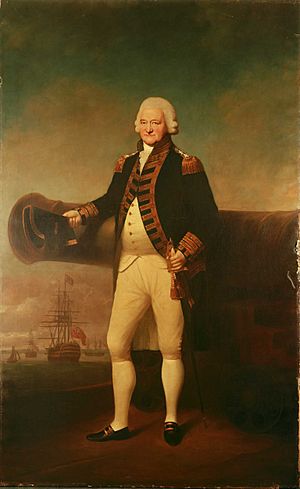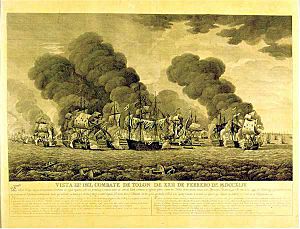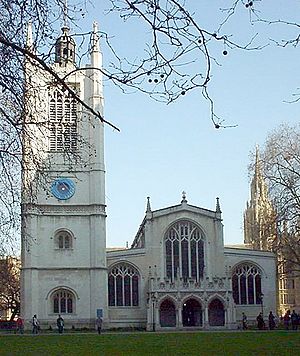Sir Peter Parker, 1st Baronet facts for kids
Quick facts for kids
Sir Peter Parker, Bt
|
|
|---|---|

Portrait by Lemuel Francis Abbott, c. 1799
|
|
| Born | 1721 Kingdom of Ireland |
| Died | 21 December 1811 (aged 89-90) Weymouth Street, London |
| Buried | |
| Allegiance | |
| Service/ |
|
| Years of service | 1743–1763, 1773–1811 |
| Rank | Admiral of the Fleet |
| Commands held | HMS Margate HMS Woolwich HMS Bristol HMS Buckingham HMS Terrible HMS Barfleur Jamaica Station Portsmouth Command |
| Battles/wars | War of Jenkins' Ear War of the Austrian Succession Seven Years' War American Revolutionary War |
Sir Peter Parker (1721 – 1811) was a very important officer in the Royal Navy, which is the British navy. He became an Admiral of the Fleet, the highest rank in the navy!
He started his naval career as a young officer. He sailed to the West Indies when the War of Jenkins' Ear began. He also fought in the Battle of Toulon during the War of the Austrian Succession. Later, as captain of HMS Bristol, he helped invade Guadeloupe during the Seven Years' War.
During the American Revolutionary War, he led naval support for British forces. He commanded a big attack on Sullivan's Island to capture Charleston, South Carolina. Even though his ships fought hard, he had to stop the attack because of many injuries and a lost ship. After this, he helped capture New York City and commanded the ships that took Long Island and Rhode Island.
Later in his career, Sir Peter Parker was in charge of the navy in Jamaica. He also became a Member of Parliament, helping to make laws for Britain. He finished his career as the Commander-in-Chief at Portsmouth, a major naval base.
Contents
Peter Parker was born in 1721. He was the third son of Christopher Parker, who was also a Rear-Admiral in the navy. Peter joined the Royal Navy when he was quite young.
He became a commander in 1735. In 1739, he was sent with a group of ships to the West Indies. This was at the start of a conflict called the War of Jenkins' Ear.
Battles and Promotions

Parker moved to different ships, including HMS Russell and HMS Firedrake. He fought in the Mediterranean Sea during the War of the Austrian Succession. In 1744, he took part in the Battle of Toulon.
He was promoted to captain in 1747. He then commanded HMS Margate. His job was to protect merchant ships in the English Channel and the Mediterranean.
Serving in the Seven Years' War
In 1757, Parker became captain of HMS Woolwich. In 1759, he moved to HMS Bristol. With HMS Bristol, he helped invade Guadeloupe in 1759 during the Seven Years' War.
He later commanded HMS Buckingham in 1760. He helped capture Belle Île in 1761. In 1762, he commanded HMS Terrible. He then retired from active duty in 1763 when the war ended.
Fighting in the American War of Independence

Sir Peter Parker was knighted in 1772. He rejoined the navy in 1773, commanding HMS Barfleur. He was promoted to commodore. In 1775, he sailed to North America with his ship, HMS Bristol. His mission was to support British forces fighting in the American Revolutionary War.
The Battle of Sullivan's Island
In June 1776, Parker led a naval attack on forts at Sullivan's Island. These forts protected Charleston, South Carolina. The American commander, Colonel William Moultrie, told his men to focus their fire on Parker's two largest ships, HMS Bristol and HMS Experiment.
These ships were hit many times by the fort's guns. HMS Bristol's ropes and masts were badly damaged. After a long and difficult fight, Parker had to stop the attack. His fleet had many casualties, and one ship, HMS Actaeon, was lost. Parker himself was injured in the leg.
Capturing New York and Rhode Island
After this battle, Parker served under Lord Howe. He helped in the capture of New York City. With his ship, HMS Chatham, he commanded the ships that captured Long Island in August 1776. He also helped capture Rhode Island in December 1776.
Later Career and High Ranks
In 1777, Parker was promoted to rear admiral. He became the Commander-in-Chief of the Jamaica Station. This meant he was in charge of all naval operations in that area.
Mentoring Horatio Nelson
While in Jamaica, Parker became a mentor and friend to Horatio Nelson. Nelson was a young officer serving on Parker's ship, HMS Bristol. Their friendship lasted for the rest of Nelson's life.
Return to England and Parliament
Parker was promoted to vice admiral in 1779. He returned to England in 1782. He was made a baronet in 1782, which is a special title.
He became a Member of Parliament (MP) for Seaford in 1784. Later, he was an MP for Maldon in 1786. This meant he helped make laws for the country.
Admiral of the Fleet
In 1787, he was promoted to full admiral. In 1793, he became the Commander-in-Chief at Portsmouth, a very important naval base.
On September 16, 1799, he reached the highest rank: Admiral of the Fleet. He was a chief mourner at Nelson's funeral in 1806, showing how close they were.
Sir Peter Parker passed away in London on December 21, 1811. He was buried at St Margaret's, Westminster.

Family Life
Around 1761, Sir Peter Parker married Margaret Nugent. They had several children, including a son named Christopher Parker, who also became a Vice-Admiral. Sir Peter Parker's grandson, also named Peter Parker, inherited his title.

